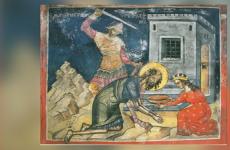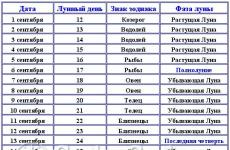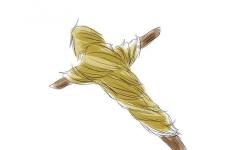A kind of aviation of the Air Force. Strategic aviation of Russia. Front-line fighter aircraft
The Air Force is rightfully considered the most mobile and operational branch of our army. The Air Force includes aviation, anti-aircraft missile and radar troops, and special forces.
Tasks of the RF Air Force
The set of tasks of the Air Force includes:
- Detection of the beginning of an attack at distant stages through aerial patrols and radar reconnaissance.
- Notification of the beginning of an attack by all headquarters of the RF Armed Forces, all branches and branches of the armed forces in all military districts of Russia, including the headquarters of civil defense.
- Reflecting an attack in the air, establishing full control over the airspace.
- Protection of military and civilian targets from air and space attacks, as well as aerial reconnaissance.
- Air support for the actions of the Land and Naval Forces of the Russian Federation.
- The defeat of military, rear and other enemy targets.
- Defeat enemy air, land, ground and sea groupings and formations, his air and sea landings.
- Transportation of personnel, weapons and military equipment, landing of troops.
- Conducting all types of aerial reconnaissance, radar reconnaissance, electronic warfare.
- Control of land, sea and air space in the border strip.
The structure of the Air Force of the Russian Federation
The structure of the RF Air Force has a complex multi-level system. By type and strength of the Air Force troops are divided into:
- aviation;
- anti-aircraft missile troops;
- radio-technical troops;
- special troops.
Aviation, in turn, is divided into:
- distant and strategic;
- front-line;
- army;
- exterminating;
- military transport;
- special.
Long-range aviation is designed to deliver missile and bomb strikes deep behind enemy lines at a considerable distance from the borders of the Russian Federation. In addition, strategic aviation is armed with nuclear missile and bomb weapons. Its aircraft are capable of covering significant distances at supersonic speeds and at high altitudes, while carrying a significant bomb load.
Fighter aviation has the task of covering the most important directions and important objects from air attack and represents the main maneuverable force of air defense. The main requirement for fighters is high maneuverability, speed, the ability to effectively conduct air combat and intercept various air targets (interceptor fighters).
Frontline aviation includes assault and bomber aircraft. The former are designed to support ground forces and naval groupings, to defeat ground targets at the forefront of hostilities, to combat enemy aircraft. Front-line bombers, unlike long-range and strategic bombers, are designed to destroy ground targets and groupings of troops at short and medium distances from basing airfields.
Army aviation in the RF Air Force is represented by helicopters for various purposes. First of all, it carries out close interaction with the ground army forces, solving a wide variety of combat and transport tasks.
Special aviation is called upon to solve various highly specialized tasks: conduct aerial reconnaissance, electronic warfare, detect ground and air targets at long distances, refuel other aircraft in the air, provide command and communications.
Special troops include:
- intelligence;
- engineering;
- aeronautical;
- meteorological;
- topogeodetic troops;
- electronic warfare forces;
- RHBZ forces;
- search and rescue forces;
- parts of electronic support and ACS;
- parts of logistics;
- rear parts.
In addition, the RF Air Force associations are divided according to their organizational structure:
- special command;
- airborne special forces;
- air armies of military transport aviation;
- Air Force and Air Defense armies (4th, 6th, 11th, 14th and 45th);
- units of the central subordination of the Air Force;
- foreign air bases.
The current state and composition of the Air Force of the Russian Federation
The active process of degradation of the Air Force, which took place in the 90s, led to a critical state of this type of troops. The number of personnel and the level of its training fell sharply.
According to many media reports, at that time Russia could count a little more than a dozen highly trained pilots of fighter and assault aviation with combat experience. Most of the pilots had little or no experience in flying aircraft.
The overwhelming majority of the aircraft fleet's equipment required major repairs, airfields and ground military facilities did not stand up to criticism.
The process of losing the combat capability of the Air Force after 2000 was completely stopped. Since 2009, the process of total modernization and overhaul of equipment has begun. So, plans for the purchase of new military equipment were brought to the level of Soviet times, the development of promising weapons began again.
As of 2018, many authoritative publications, including foreign ones in terms of size and level of equipment, put the Air Force of our country in second place after the US Air Force. However, they note that the growth in the number and equipment of the Chinese air force is ahead of the Russian air force and in the very near future the Chinese air force may equal ours.
During the military operation from Syria, the Air Force was not only able to conduct full-fledged combat tests of new weapons and air defense systems, but also, through the rotation of the numerical strength, to conduct "shelling" in combat conditions for the majority of fighter and assault aircraft pilots. 80-90% of pilots now have combat experience.
Military equipment
Fighter aviation in the army is represented by the SU-30 and SU-35 multipurpose fighters of various modifications, the front-line fighters MIG-29 and SU-27, and the MIG-31 interceptor fighter.
Frontline aviation is dominated by the SU-24 bomber, the SU-25 attack aircraft and the SU-34 fighter-bomber.
Long-range and strategic aviation is armed with TU-22M and TU-160 supersonic strategic missile-carrying bombers. There is also a number of obsolete turboprop TU-95, modernized to the modern level.
Transport aviation includes transport aircraft AN-12, AN-22, AN-26, AN-72, AN-124, IL-76 and passenger AN-140, AN-148, IL-18, IL-62, TU -134, TU-154 and the joint Czechoslovak-Russian development Let L-410 Turbolet.
Special aviation includes AWACS aircraft, air command posts, reconnaissance aircraft, tanker aircraft, electronic warfare and reconnaissance aircraft, and relay aircraft.
The helicopter fleet is represented by attack helicopters KA-50, KA-52 and MI-28, transport-combat MI-24 and MI-25, multipurpose Ansat-U, KA-226 and MI-8, as well as a heavy transport helicopter MI- 26.
In the future, the air forces will receive: the front-line fighter MIG-35, the fifth generation PAK-FA fighter, the SU-57 multipurpose fighter, the new A-100 type AWACS aircraft, the PAK-DA multipurpose strategic bomber-missile carrier, the MI-38 multipurpose helicopters and PLV, attack helicopter SBV.
Among the air defense systems in service with the Air Force are the world famous long-range anti-aircraft missile systems S-300 and S-400, short-range missile and cannon systems Pantsir S-1 and Pantsir S-2. In the future, the appearance of a complex of the S-500 type is expected.
After the adoption of GPV-2020, officials quite often talk about the rearmament of the Air Force (well, or more broadly, the supply of aviation systems to the RF Armed Forces). At the same time, the specific parameters of this rearmament and the size of the Air Force by 2020 are not directly given. In view of this, many media outlets present their forecasts, but they are presented, as a rule, in tabular form - without arguments or a calculation system.
This article is just an attempt to predict the combat strength of the RF Air Force by that date. All information was collected from open sources - from media materials. There are no claims to absolute accuracy, because the ways of the state ... ... defense order in Russia are inscrutable, and, often, are a secret even for those who form it.
Air Force total strength
So, let's start with the main thing - with the total strength of the Air Force by 2020. This number will be formed from new-built aircraft and their modernized "senior colleagues".
In his programmatic article, Vladimir Putin pointed out that: “... In the coming decade, the troops will receive ... more than 600 modern aircraft, including fifth generation fighters, over a thousand helicopters". At the same time, the current Minister of Defense S.K. Shoigu recently cited slightly different data: “... by the end of 2020, we have to receive from industrial enterprises about two thousand new aviation complexes, including 985 helicopters».
The numbers are of the same order, but there are also differences in details. What is the reason for this? For helicopters, the delivered vehicles may no longer be counted. Some changes in the parameters of GPV-2020 are also possible. But only they will require changes in funding. Theoretically, this is facilitated by the refusal to resume production of the An-124 and a slight reduction in the number of helicopter purchases.

Sergei Shoigu mentioned, in fact, no less than 700-800 aircraft (we will subtract helicopters from the total number). Article V.V. This does not contradict Putin (more than 600 planes), but “more than 600” does not really correlate with “almost 1000”. And money for "extra" 100-200 machines (even taking into account the abandonment of "Ruslans") will need to be raised additionally, especially if you buy fighters and front-line bombers figure - up to a quarter of a trillion rubles for 200 cars, despite the fact that PAK FA or Su-35S are more expensive).
Thus, an increase in purchases is most likely due to the cheaper combat training Yak-130 (all the more so that it is very necessary), attack aircraft and UAVs (it seems, according to media materials, work has intensified). Although the additional purchase of the Su-34 up to 140 units. can also take place. Now there are about 24 of them. + about 120 Su-24M. Will be - 124 pcs. But to replace the front-line bombers in the 1 x 1 format, one and a half dozen more Su-34s will be required.

Based on the given data, it seems advisable to take the average figures of 700 aircraft and 1000 helicopters. Total - 1700 boards.
Now let's move on to the modernized technology. In general, by 2020, the share of new equipment in the Armed Forces should be 70%. But this percentage is not the same for different types and types of troops. For the Strategic Missile Forces - up to 100% (sometimes they say 90%). For the Air Force, figures were quoted in the same 70%.
I also admit that the share of new equipment will "reach" 80%, but not due to an increase in its purchases, but due to a greater write-off of old machines. However, this article uses a 70/30 ratio. Therefore, the forecast is moderately optimistic. By simple calculations (X = 1700x30 / 70), we get (approximately) 730 modernized sides. In other words, the number of the RF Air Force by 2020 is planned in the region of 2430-2500 aircraft and helicopters.
They seem to have figured out the total. Let's get down to specifics. Let's start with helicopters. This is the most highlighted topic, and deliveries are already in full swing.
Helicopters
It is planned to have 3 (!) Models for attack helicopters - (140 units), (96 units), as well as Mi-35M (48 units). A total of 284 units were planned. (not including some of the vehicles lost in accidents).
Everyone around the world is well aware that the Russian army is one of the most powerful on our planet. And it is considered as such by right. The air force is part of the RF Armed Forces and is one of the key links in our army. Therefore, it is necessary to talk about the Air Force in more detail.
A bit of history
History in the modern sense begins in 1998. It was then that the Air Force, which we know today, was formed. And they were formed as a result of the merger of the so-called troops and the Air Force. True, even now they no longer exist as such. Since the past, 2015, there has been a VKS - Aerospace Forces. By uniting subunits of space and air forces, it was possible to rally potential and resources, as well as to concentrate command in one hands - due to which the effectiveness of the forces also increased. In any case, this is exactly how the need to form a VKS was justified.
These troops carry out many tasks. They repel aggression in the air and space sphere, protect the earth, people, the country and important objects from strikes coming from the same place, and provide air support for the hostilities of other military units of Russia.

Structure
The Russian Federation (after all, many are more accustomed to calling them the old way than the VKS), include many divisions. This is aviation, as well as radio and anti-aircraft weapons in the first place. These are the arms of the Air Force. The structure also includes special troops. These include reconnaissance, as well as communications of automated control systems and radio technical support. Without this, the Russian Air Force cannot exist.
The special troops also include meteorological, topogeodetic, engineering, RChBZ, aeronautical, and also engineering. But this is not a complete list. It is also complemented by support, search and rescue, and also meteorological. But, in addition to the above, there are divisions whose main task is to protect the military command and control bodies.
Other structure features
It should be noted that the structure that distinguishes the air force of the Russian Federation also has subdivisions. The first is long-range aviation (DA). The second is the military transport (MTA). The third is operational tactical (OTA) and, finally, the fourth is army (AA). But that's not all. Units can include special, transport, reconnaissance, fighter aircraft, as well as assault and bomber aircraft. And each has its own tasks, which they are obliged to carry out by the Air Force.
The composition, however, still has a certain basis on which the whole structure rests. Naturally, these are air bases and brigades belonging to the Aerospace Defense Forces.

Situation in the XXI century
Every person, even a little versed in this topic, knows perfectly well that in the 90s, the air force of the Russian Federation was actively degraded. And all due to the fact that the number of personnel of the troops and the level of their training was very small. Plus, the technology was not particularly novel, and there were not enough airfields. In addition, the structure was not funded, and therefore there were practically no flights. But in the 2000s, the situation began to improve. To be more precise, everything began to progress in 2009. It was then that fruitful and capital work began on the repair and modernization of the entire fleet of the Russian Air Force.
Perhaps the impetus for this was the statement of the commander-in-chief of the troops - A. N. Zelin. In 2008, he said that the aerospace defense of our state was in a catastrophic state. Therefore, the purchase of equipment and the improvement of the entire system as a whole began to be made.

Symbolism
The Air Force flag is very bright and conspicuous. It is a blue panel with two silver propellers in the center. They seem to overlap with each other. An anti-aircraft gun is also depicted along with them. And the background is made up of silvery wings. In general, it is quite original and symbolic. Even from the center of the panel, golden rays seem to be diverging (there are 14 of them). By the way, their location is strictly regulated - this is not a chaotic choice. If you turn on fantasy and imagination, then it begins to seem as if this emblem is in the middle of the sun, blocking it - that's why the rays.
And if you look into history, you can understand that this is so. Because in Soviet times, the flag was a blue cloth with a golden sun, in the middle of which was a red star with a hammer and sickle in the center. And just below - the silvery wings, which seem to be attached to the black ring of the propeller.

It is worth noting that the Federation, together with the US Air Force, planned to conduct joint anti-terrorist exercises in 2008. This was to happen in the Far East. The scenario was planned as follows: terrorists hijack a plane at the airport, and the troops prevent the consequences. The Russian side was supposed to bring to action four fighters, search rescue services and an early warning aircraft. The US Air Force was required to participate in a civilian liner and fighters. Plus the notorious plane. However, shortly before the scheduled event, literally a week before, it was reported that it had been decided to celebrate the exercises. Many believe that the cause was the strained relationship between NATO and Russia.
Formation of the Air Force and Air Defense Forces of the Russian Federation (1992-1998)The process of the collapse of the Soviet Union and the events that followed significantly weakened the Air Force and Air Defense Forces. A significant part of the aviation group (about 35%) remained on the territory of the former Soviet republics (more than 3400 aircraft, including 2500 combat).
Also on their territories remained the most prepared for the basing of military aviation airfield network, which in comparison with the USSR was reduced in the Russian Federation by almost half (primarily in the Western strategic direction). The level of flight and combat training of Air Force pilots dropped sharply.
In connection with the disbandment of a large number of radio engineering units, a continuous radar field over the territory of the state disappeared. The general air defense system of the country was also significantly weakened.
Russia, the last of the former republics of the USSR, began building the Air Force and Air Defense Forces as an integral part of its own Armed Forces (decree of the President of the Russian Federation of May 7, 1992). The priorities of this construction were the prevention of a significant decrease in the level of combat effectiveness of formations and units of the Air Force and Air Defense Forces, the reduction of personnel due to the revision and optimization of their organizational structure, the removal of obsolete weapons and military equipment, etc.
During this period, the combat strength of the Air Force and air defense aviation was represented almost exclusively by fourth-generation aircraft (Tu-22M3, Su-24M / MR, Su-25, Su-27, MiG-29 and MiG-31). The total strength of the Air Force and Air Defense Aviation was reduced by almost three times - from 281 to 102 air regiments.
As of January 1, 1993, the RF Air Force had in combat composition: two commands (long-range and military transport aviation (VTA)), 11 aviation associations, 25 air divisions, 129 air regiments (including 66 combat and 13 military transport ). The aircraft fleet consisted of 6,561 aircraft, excluding aircraft stored at the reserve bases (including 2,957 combat aircraft).
At the same time, measures were taken to withdraw air force formations, formations and units from the territories of far and near abroad countries, including the 16th Air Force (VA) from Germany, and 15 VA from the Baltic countries.
Period 1992 - early 1998 became a time of great painstaking work by the governing bodies of the Air Force and the Air Defense Forces to develop a new concept of the military development of the Russian Armed Forces, its aerospace defense with the implementation of the principle of defense sufficiency in the development of the Air Defense Forces and an offensive nature in the use of the Air Force.

During these years, the Air Force had to take a direct part in the armed conflict on the territory of the Chechen Republic (1994-1996). Subsequently, the experience gained made it possible to carry out the active phase of the counter-terrorist operation in the North Caucasus in 1999-2003 in a more thoughtful and highly effective manner.
In the 1990s, in connection with the beginning of the disintegration of the single anti-aircraft field of the Soviet Union and the former countries - members of the Warsaw Pact Organization, there was an urgent need to recreate its analogue within the borders of the former Soviet republics. In February 1995, the countries of the Commonwealth of Independent States (CIS) signed an Agreement on the creation of a Joint Air Defense System of the CIS member states, designed to solve the tasks of protecting state borders in the airspace, as well as to conduct coordinated collective actions of air defense forces to repel a possible air defense. - a space attack on one of the countries or a coalition of states.
However, assessing the acceleration of the physical aging of weapons and military equipment, the Defense Committee of the State Duma of the Russian Federation came to disappointing conclusions. As a result, a new concept of military development was developed, where it was supposed to reorganize the branches of the Armed Forces even before 2000, reducing their number from five to three. Within the framework of this reorganization, it was necessary to unite in one form two independent branches of the Armed Forces: the Air Force and the Air Defense Forces.
A new type of the Armed Forces of the Russian Federation
In accordance with the decree of the President of the Russian Federation of July 16, 1997 No. 725 "On priority measures to reform the Armed Forces of the Russian Federation and improve their structure" by January 1, 1999, a new service of the Armed Forces, the Air Force, was formed. In a short time, the Air Force High Command developed a regulatory and legal framework for a new type of Armed Forces, which made it possible to ensure the continuity of control of the Air Force formations, maintain their combat readiness at the required level, fulfill the tasks of air defense combat duty, as well as conduct operational training.

By the time the Armed Forces of the Russian Federation were merged into a single service, the Air Force consisted of 9 operational formations, 21 aviation divisions, 95 air regiments, including 66 combat aviation regiments, 25 separate aviation squadrons and detachments based at 99 airfields. The total number of aircraft fleet was 5,700 aircraft (including 20% of training aircraft) and more than 420 helicopters.
The Air Defense Forces consisted of: an operational-strategic formation, 2 operational, 4 operational-tactical formations, 5 air defense corps, 10 air defense divisions, 63 units of anti-aircraft missile forces, 25 fighter air regiments, 35 units of radio technical troops, 6 formations and reconnaissance units and 5 parts of electronic warfare. In service there were: 20 aircraft of the A-50 radar surveillance and guidance aviation complex, more than 700 air defense fighters, more than 200 anti-aircraft missile divisions and 420 radio engineering units with radar stations of various modifications.
As a result of the measures taken, a new organizational structure of the Air Force was created, which included two air armies: the 37th Air Army of the Supreme High Command (strategic) (VA VGK (CH) and the 61st VA VGK (VTA). The Air Force and Air Defense Forces were formed, operatively subordinate to the commander of the military districts The Moscow Air Force and Air Defense District was created in the western strategic direction.
Further construction of the organizational and staff structure of the Air Force was carried out in accordance with the Plan for the Construction and Development of the Armed Forces for 2001-2005, approved in January 2001 by the President of the Russian Federation.
In 2003, army aviation was transferred to the Air Force, in 2005-2006. - part of military air defense formations and units equipped with S-300V anti-aircraft missile systems and Buk complexes. In April 2007, the Air Force adopted the S-400 Triumph anti-aircraft missile system, designed to defeat all modern and promising aerospace attack weapons.

At the beginning of 2008, the Air Force included: an operational-strategic formation (KSpN), 8 operational and 5 operational-tactical formations (air defense corps), 15 formations and 165 units. In August of the same year, units of the Air Force took part in the Georgian-South Ossetian military conflict (2008) and in the operation to force Georgia to peace. During the operation, the Air Force carried out 605 sorties and 205 helicopter sorties, including 427 sorties and 126 helicopter sorties for combat missions.
The military conflict revealed certain shortcomings in the organization of combat training and the control system of Russian aviation, as well as the need for a significant renewal of the Air Force's aircraft fleet.
The Air Force in the new guise of the Armed Forces of the Russian Federation
In 2008, the transition to the formation of a new image of the Armed Forces of the Russian Federation (including the Air Force) began. In the course of the measures taken, the Air Force switched to a new organizational and staff structure, more consistent with modern conditions and realities of the time. The Air Force and Air Defense Commands were formed, subordinate to the newly created operational-strategic commands: Western (headquarters - St. Petersburg), Southern (headquarters - Rostov-on-Don), Central (headquarters - Yekaterinburg) and Eastern ( headquarters - Khabarovsk).
The Air Force High Command was assigned the tasks of planning and organizing combat training, the long-term development of the Air Force, as well as training the commanding staff of command and control bodies. With this approach, responsibility for the training and use of forces and means of military aviation was distributed and duplication of functions was excluded, both in peacetime and during the period of hostilities.
In 2009–2010 the transition to a two-tier (brigade-battalion) control system of the Air Force was carried out. As a result, the total number of air force formations was reduced from 8 to 6, all air defense formations (4 corps and 7 air defense divisions) were reorganized into 11 aerospace defense brigades. At the same time, there is an active renewal of the aircraft fleet. The fourth generation aircraft are being replaced by their new modifications, as well as modern types of aircraft (helicopters), which have wider combat capabilities and flight performance characteristics.
Among them: front-line bombers Su-34, multipurpose fighters Su-35 and Su-30SM, various modifications of the supersonic all-weather long-range fighter-interceptor MiG-31, medium-range cargo military transport aircraft of the new generation An-70, light military transport An-140-100 aircraft, a modified Mi-8 assault military transport helicopter, a Mi-38 multi-purpose medium-range helicopter with gas turbine engines, Mi-28 combat helicopters (various modifications) and Ka-52 Alligator.

As part of the further improvement of the air (aerospace) defense system, a new generation of S-500 air defense systems is currently being developed, in which it is planned to apply the principle of separate solution of the tasks of destroying ballistic and aerodynamic targets. The main task of the complex is to combat the combat equipment of medium-range ballistic missiles, and, if necessary, against intercontinental ballistic missiles in the final section of the trajectory and, within certain limits, in the middle section.
The modern Air Force is the most important component of the Armed Forces of the Russian Federation. Currently, they are designed to solve the following tasks: repelling aggression in the aerospace sphere and protecting from air strikes command posts of the highest echelons of state and military administration, administrative and political centers, industrial and economic regions, the most important objects of the country's economy and infrastructure, groupings troops (forces); destruction of troops (forces) and enemy targets using conventional, high-precision and nuclear weapons, as well as for air support and combat operations of troops (forces) of other branches of the Armed Forces and combat arms.
Material prepared by the Research Institute (Military History)
Military Academy of the General Staff
Of the Armed Forces of the Russian Federation
The Air Force includes the following types of troops:
- aviation (kind of aviation - bomber, assault, air defense fighter aircraft, reconnaissance, transport and special),
- anti-aircraft missile troops,
- radio-technical troops,
- special troops,
- parts and institutions of the rear.

Bomber aviation is armed with long-range (strategic) and front-line (tactical) bombers of various types. It is designed to defeat groupings of troops, destroy important military, energy facilities and communication centers, mainly in the strategic and operational depth of the enemy's defense. The bomber can carry bombs of various calibers, both conventional and nuclear, as well as guided air-to-surface missiles.
Assault aircraft is intended for air support of troops, destruction of manpower and objects mainly at the front line, in the tactical and immediate operational depth of the enemy, as well as for fighting enemy aircraft in the air.
One of the main requirements for an attack aircraft is high accuracy of destruction of ground targets. Armament: large-caliber guns, bombs, rockets.
Fighter aircraft air defense is the main maneuverable force of the air defense system and is designed to cover the most important areas and objects from enemy air attacks. It is capable of destroying the enemy at maximum distances from defended objects.
The air defense aviation is armed with air defense fighter planes, combat helicopters, special and transport aircraft and helicopters.
Reconnaissance aircraft is intended for conducting aerial reconnaissance of the enemy, terrain and weather; it can destroy hidden enemy objects.
Reconnaissance flights can also be carried out by bomber, fighter-bomber, assault and fighter aircraft. For this, they are specially equipped with day and night cameras at various scales, high-resolution radio and radar stations, heat direction finders, sound recording and television equipment, and magnetometers.
Reconnaissance aviation is subdivided into tactical, operational and strategic reconnaissance aviation.
Transport aviation designed for the transportation of troops, military equipment, weapons, ammunition, fuel, food, airborne assault landing, evacuation of the wounded, sick, etc.
Special aviation designed for long-range radar detection and guidance, refueling aircraft in the air, conducting electronic warfare, radiation, chemical and biological protection, providing control and communications, meteorological and technical support, rescuing crews in distress, evacuating the wounded and sick.
Anti-aircraft missile troops are designed to protect the most important facilities of the country and groupings of troops from enemy air strikes.
They constitute the main firepower of the air defense system and are armed with anti-aircraft missile systems and anti-aircraft missile systems for various purposes, possessing great firepower and high accuracy in destroying enemy air attack weapons.
Radio-technical troops- the main source of information about the air enemy and are designed to conduct his radar reconnaissance, control the flights of his aviation and the observance of the rules for the use of airspace by the aircraft of all departments.
They provide information about the beginning of an air attack, combat information for anti-aircraft missile forces and air defense aviation, as well as information for commanding air defense formations, units and subunits.
The radio technical troops are armed with radar stations and radar systems capable of detecting not only air targets, but also surface targets at any time of the year or day, regardless of meteorological conditions and interference.
Communication units and subdivisions are intended for the deployment and operation of communication systems in order to ensure command and control of troops in all types of combat activities.
Electronic warfare units and subdivisions are intended for jamming airborne radars, bombsights, communications and radio navigation equipment of enemy air attack.
Communication and radio technical support units and subdivisions are designed to provide control of aviation units and subunits, air navigation, takeoff and landing of aircraft and helicopters.
Units and subdivisions of engineering troops, as well as parts and subdivisions of radiation, chemical and biological protection are designed to perform the most difficult tasks of engineering and chemical support, respectively.






